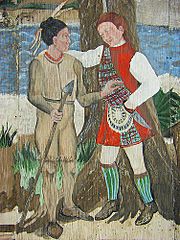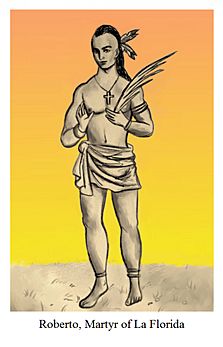Guale facts for kids
| Total population | |
|---|---|
| Extinct as tribe | |
| Regions with significant populations | |
| Georgia/Sea Islands | |
| Languages | |
| Guale | |
| Religion | |
| Animist | |
| Related ethnic groups | |
| Mississippian culture; possibly ancestors of Muskogean peoples:Creek |
The Guale were a group of Native American people. They lived in a chiefdom along the coast of what is now Georgia and its Sea Islands. These people were part of the Mississippian culture.
In the late 1500s, Spanish Florida started building Catholic missions in the Guale territory. But by the late 1600s and early 1700s, the Guale society faced big challenges. Many Guale people died from new diseases. Other tribes also attacked them. The Guale who survived either moved to Spanish mission areas or stayed near the Georgia coast. They joined with other survivors and became known as the Yamasee. This new group was a mix of different peoples.
Contents
Guale Language
| Guale | |
|---|---|
| Region | Georgia |
| Extinct | ca. 1700; perhaps became Yamasee |
| Language family |
unclassified
|
| Linguist List | 07u |
Experts are not sure how to classify the Guale language. Some early ideas suggested it was a Muskogean language. However, historian William C. Sturtevant showed that some recorded words thought to be Guale were actually from the Creek language. Creek is a different Muskogean language.
Historical records mention that a Jesuit Brother named Domingo Agustín Váez wrote down Guale grammar in 1569. Sadly, these writings have never been found. The Guale are believed to have been a Mississippian culture group. They had a chiefdom along the Georgia coast when the Spanish first explored the area.
Guale History
Early Guale Life
Archaeological studies tell us that the people who became the Guale lived along the Georgia coast and Sea Islands. They were there from at least 1150 AD. Archaeologists call these early Guale cultures the Savannah phase (1150 to 1300 AD) and the Irene phase (1300 to about 1600 AD).
These early people were organized into chiefdoms. They built large platform mounds. These mounds were big earthworks that needed many people to build them. The Guale used these mounds for ceremonies, religious events, and burials.
Meeting Europeans
In 1562, French explorers led by Jean Ribault met the Guale. The French called them the Oade, after their chief. The Guale had good relations with the French settlement called Charlesfort. This settlement was on Parris Island in what is now South Carolina.
Later, the Spanish settled in St. Augustine in Spanish Florida. They also met the Guale. The Spanish soon tried to bring the Guale into their mission system. The Guale territory became one of the four main mission areas of Spanish Florida. The others were the Timucua, Mocama, and Apalachee Provinces.
The Spanish Guale Province covered the Guale's land. This was along the Atlantic coast and Sea Islands. It was north of the Altamaha River and south of the Savannah River. It included islands like Ossabaw, St. Catherine's, Sapelo, Tybee, and Wassaw. By the mid-1600s, the Spanish had six Catholic missions in Guale land. These included Nuestra Señora de Guadalupe de Tolomato and Santa Catalina de Guale. Their biggest settlements were likely on St. Catherine's Island.
The Guale Province was the least stable of the mission areas. The first Guale rebellion, called Juanillo's Revolt, started on October 4, 1597. The Guale rebelled again in 1645. They also secretly traded with French privateers. This gave them other ways to get goods.
Joining with Other Tribes
Many Native Americans in the Southeast were drawn to the Spanish mission areas. They wanted to trade for European goods. During the 1600s, various non-Guale Indians settled near the Guale missions. Most were from a region in north-central Georgia called La Tama by the Spanish.
In the 1660s, the Westo tribe attacked La Tama. The Westo were well-armed. This scattered the La Tama people. Some moved to towns on the lower Chattahoochee River, like Coweta and Cussita. Others went to the Apalachee mission areas or the Guale province. The La Tama spoke a dialect of Hitchiti, a Muskogean language.
In 1675, the Spanish first used the name Yamasee for these new refugees. They thought they were similar to the La Tama. In Guale Province, some Yamasee joined the missions. Others settled nearby.
Loss of Land and People
Between 1675 and 1684, the Westo tribe destroyed all Spanish missions in Georgia. The Westo were supported by English colonists from Carolina and Virginia. Attacks by English-supported pirates also helped break up the missions. In 1680, pirates attacked Mission Santa Catalina de Guale. By 1684, the Spanish and Native Americans had left all six missions.
The La Tama Yamasee, Guale, and other refugees spread out across the Southeast. Some moved to new missions in Spanish Florida. But most did not want Spanish rule. They felt Spain could not protect them. They also did not like that Spain failed to give them firearms. The Guale people mostly moved to the Apalachee or Apalachicola regions.
The Rise of the Yamasee
Around 1684, a small group of Yamasee-Guale refugees moved north. They were led by Chief Altamaha. They settled near the mouth of the Savannah River. That year, a Scottish colony called Stuarts Town was founded in South Carolina. It was near the Savannah River. Stuarts Town lasted only about two years. But during that time, the Scots and the Yamasee-Guale became good friends.
In late 1684, these Native Americans got firearms from the Scots. They raided Timucua Province. They badly damaged the mission Santa Catalina de Afuyca. They returned to Stuarts Town with 22 captives, whom they sold as slaves. Over the next two years, news of these successes spread. The number of "Yamasee" Indians near Port Royal Sound grew quickly. Even though they were called "Yamasee," the Guale were still a big part of this group.
Spanish forces destroyed Stuarts Town. In the old Guale Province, they fought back strongly against South Carolina. But the alliance between the Yamasee and colonial South Carolina grew stronger. The "Yamasee" who moved to the Port Royal area in 1685 were rebuilding the old La Tama chiefdom. But they also included many Guale and other Native Americans, mostly of Muskogean background.
The Yamasee lived in South Carolina until they were defeated in the Yamasee War of 1715. After this war, the survivors were scattered. The Yamasee people as a group broke apart. But while they existed, the Yamasee were a mix of different peoples. European colonists described their towns as Upper Yamasee or Lower Yamasee towns. The Lower Towns were mostly La Tama Indians. These included Altamaha (named after the chief), Ocute, and Chechesee.
The Guale were the main group in the Upper Towns. Other groups were also part of these towns. Upper Yamasee Towns with mostly Guale people likely included Pocotaligo, Pocosabo, and Huspah. Other Upper Towns, like Tulafina, Sadketche, and Tomatley, were probably mixed. They had Guale, La Tama, and others. It's possible the La Tama had spent time in missions and become somewhat Christian. They may have sought out the Guale, who were also missionized.
In 1702, Carolina Governor James Moore led an invasion into Spanish Florida. His men destroyed the few "refugee missions" in Guale. By 1733, there were so few Guale people left. They did not resist when James Oglethorpe started the Province of Georgia.
A similar mission area called Mocama was just south of Guale. It was named for a Timucuan chiefdom. Mocama was on the coast between the Altamaha River and St. Johns River in Florida.



